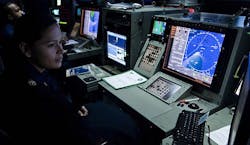Air Force researchers choose Matrix for CERFER program to track targets amid RF jamming
Officials of the Air Force Research Laboratory at Wright-Patterson Air Force Base, Ohio, announced a $36 million contract Wednesday to Matrix Research Inc. in Dayton, Ohio, for the Contested Environment Radio Frequency Exploitation And Research (CERFER) program, which seeks to address problems of concurrent detection, tracking, imaging, classification, and identification of targets.
On the CERFER program, Matrix research sensor and signal processing experts will investigate advances in radar subsystems, particularly in hardware, software, and algorithm solutions to detect, track, image, and identify targets within contested areas. This includes exploiting passive and active signals.
Related: Programmable radar and adaptive electronic warfare take center stage
Research that Matrix will perform includes developing models, hardware, software, algorithms, and techniques spanning basic, applied, and advanced research for active and passive sensing. Matrix was the contract winner among six bidders for the CERFER program.
Matrix's goal in the CERFER program is to advance RF sensing hardware, software, and algorithms using spatial diversity, waveform diversity, transmit and receive adaptivity, signals of opportunity, and similar resources to enhance sensor performance.
The idea is to address problems of concurrent detection, tracking, imaging, classification, and identification of targets within contested environments with single- and distributed-sensing architectures. The project will involve developing models, hardware, software, algorithms, and techniques for active and passive sensing.
Related: DARPA issues solicitation for EW program to counter digitally programmable adaptive radar
Air Force researchers primarily are keen for Matrix to investigate distributed sensing architectures; distributed active detection; distributed active and passive tracking; distributed active and passive imaging; distributed active and passive identification and classification; synthetic aperture radar (SAR) detection, tracking, imaging, and identification; and fully adaptive radar (FAR) detection, tracking, imaging, and identification.
The CERFER program will last for seven years -- five years for the ordering period and two years to complete all tasks and submit the final report.
On this contract Matrix Research will do the work in Dayton, Ohio, and should be finished by May 2021. For more information contact Matrix Research online at www.matrixresearch.com, or the Air Force Research Laboratory at www.wpafb.af.mil/afrl.
